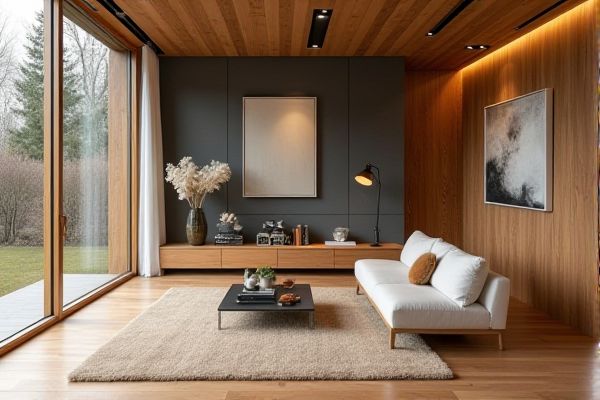
Engineered wood offers enhanced stability and resistance to moisture compared to solid wood, making it ideal for areas prone to humidity, while solid wood provides a natural aesthetic and can be refinished multiple times for longevity. Discover how each material impacts your project's durability and design by reading the rest of the article.
Table of Comparison
| Feature | Engineered Wood | Solid Wood |
|---|---|---|
| Composition | Layered wood veneers bonded with adhesives | Single, solid piece of natural wood |
| Durability | Stable, less prone to warping and cracking | Highly durable but can warp, crack over time |
| Cost | Generally more affordable | Usually higher, premium pricing |
| Appearance | Varies; can mimic different wood grains | Authentic natural wood grain and texture |
| Installation | Easier due to uniformity and size stability | More complex; requires acclimation and precision |
| Environmental Impact | Uses fewer natural resources; can use recycled materials | Depends on sustainable harvesting; higher wood consumption |
| Maintenance | Low maintenance; resistant to moisture damage | Requires regular care; sensitive to humidity changes |
| Lifespan | 10-30 years depending on usage and quality | 50+ years with proper care |
Introduction to Engineered Wood and Solid Wood
Engineered wood consists of multiple layers of wood veneers or fibers bonded together with adhesives, creating a durable and stable material resistant to warping and moisture. Solid wood, sourced directly from natural timber, offers unique grain patterns and strength but is more susceptible to environmental changes such as humidity and temperature fluctuations. Both materials are widely used in furniture and flooring, with engineered wood providing enhanced dimensional stability and solid wood valued for its natural aesthetics and longevity.
Composition and Manufacturing Process
Engineered wood consists of multiple layers of wood veneers or fibers bonded together using adhesives, designed to enhance stability and reduce warping, while solid wood is a single piece cut directly from a tree, offering natural grain and strength. The manufacturing process of engineered wood involves pressing and gluing layers under heat and pressure, which improves durability and moisture resistance, contrasting with solid wood's straightforward milling and drying. Engineered wood products include plywood, MDF, and particleboard, each tailored for specific structural and aesthetic applications, whereas solid wood is prized for its authenticity and long lifespan.
Durability and Longevity Comparison
Engineered wood offers enhanced durability through its multi-layer construction, resisting warping and moisture better than solid wood, which is prone to cracking and expanding over time. Solid wood, however, provides exceptional longevity when properly maintained, often lasting several decades due to its dense, natural fibers and the ability to be refinished multiple times. Your choice between engineered and solid wood should consider the specific conditions of use, such as exposure to humidity and wear, to maximize the lifespan of your wood products.
Aesthetic Differences: Appearance and Texture
Engineered wood offers a consistent appearance with smooth textures and uniform grain patterns due to its layered construction, making it ideal for modern and minimalist designs. Solid wood displays natural variations with unique grain patterns, knots, and textures, providing a rustic and authentic aesthetic that evolves over time. The choice between engineered and solid wood significantly impacts the visual warmth and tactile experience of interiors.
Cost Analysis: Engineered vs Solid Wood
Engineered wood typically offers a lower upfront cost compared to solid wood, making it a budget-friendly option for large projects or renovations. Maintenance and repair costs for engineered wood can be higher over time due to its layered construction, whereas solid wood can be refinished multiple times, extending its lifespan and value. Total cost considerations include installation, durability, and potential resale value, with solid wood often providing better long-term investment despite higher initial expenses.
Environmental Impact and Sustainability
Engineered wood typically has a lower environmental impact than solid wood due to its efficient use of smaller wood pieces and recycled materials, reducing the need for harvesting large old-growth trees. It uses adhesives and resins that can vary in eco-friendliness, so selecting products with low VOC emissions and formaldehyde-free certifications enhances sustainability. Your choice of engineered wood supports forest conservation and reduces waste, but solid wood may offer better longevity and carbon sequestration when sourced from responsibly managed forests.
Installation and Maintenance Requirements
Engineered wood requires simpler installation due to its dimensional stability and pre-finished surfaces, making it suitable for floating or glue-down methods. Solid wood demands more precise acclimation and professional installation because it expands and contracts with humidity changes. Maintenance for engineered wood involves less frequent refinishing, while solid wood needs periodic sanding and resealing to preserve its appearance and durability.
Resistance to Moisture and Temperature Changes
Engineered wood offers superior resistance to moisture and temperature changes due to its layered construction and adhesive bonding, which minimize expansion and contraction compared to solid wood. Solid wood is more prone to warping, cracking, or swelling when exposed to fluctuating humidity and temperature levels. Choosing engineered wood for your projects ensures enhanced durability and stability in environments with variable climatic conditions.
Popular Applications in Home and Commercial Projects
Engineered wood is widely used in flooring, cabinetry, and furniture due to its moisture resistance and dimensional stability, making it ideal for kitchens and bathrooms in both residential and commercial spaces. Solid wood, prized for its natural beauty and durability, is commonly chosen for structural elements, high-end furniture, and decorative finishes where longevity and aesthetics are priorities. Your choice between engineered and solid wood depends on the specific application requirements, budget, and environmental conditions of your project.
Choosing the Right Wood: Factors to Consider
Choosing the right wood requires evaluating durability, cost, and environmental impact between engineered wood and solid wood. Engineered wood offers greater stability and resistance to warping due to its multi-layer construction, making it ideal for areas with fluctuating humidity. Solid wood provides natural beauty and long-term value but demands more maintenance and can be prone to expansion or contraction depending on climate conditions.
 homyna.com
homyna.com